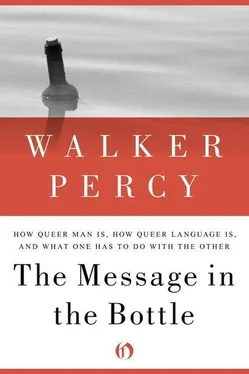There is no necessary relationship between a name and that which is named beyond the coupling of name and thing by namer.
1.31. It is the peculiar property of a name, a class of sounds, not only that it can be coupled with a class of things but also that in the coupling the sound is transformed and “becomes” the thing.*
The word glass sounds brittle but it is not. The word brittle sounds brittle but it is not.
The word sparkle seems to sparkle for English-speakers but not for Germans. The word funkeln seems to sparkle for Germans but not for English-speakers.†
1.311. A symbol must be unlike what it symbolizes in order that it may be transformed and “become” what is symbolized.
The sound cup can become a symbol for cup. A cup cannot be a symbol for cup.
1.4. The coupling relation of a sentence is not like any other world relation. Yet — indeed for this very reason — it may symbolize any world relation whatever, subject only to the context of utterance and the rules of sentence formation.
1.41. A sentence may mean anything it is used to mean.
Thus, the sentence baby chair uttered by a two-year-old can be reliably understood by its mother as asserting within different contexts any number of different relationships. It can also be understood as a command or a question. Some possible meanings of the two-word telegraph sentence baby chair :
That is a baby chair (chair for the baby).
That is a little chair.
Baby is in his chair.
Baby wants his chair.
Where is baby chair?
Bring baby chair.
Bring chair for baby.*
1.42. The coupling relation of a sentence is not isomorphic with the world relation it symbolizes.
It is true that the sentence John loves Mary is a coupling of sentence elements (a child could say John Mary and be understood if John was loving Mary at the time) referring to a dyadic relationship between John and Mary.
But it is also true that although the sentence John gives a ring to Mary refers to a triadic relation obtaining between John, the ring, and Mary, the sentence is still a coupling of elements: (1) we are speaking about John; (2) we are saying something about him.
It is also true that although the sentence John plays bridge with Mary and Ted and Alice refers to a tetradic relation obtaining between John and Mary and Ted and Alice, the sentence is still a coupling of elements: (1) we are speaking about John; (2) we are saying something about him.*
1.5. When one studies dyadic behavior, i.e., the learned response of an organism to stimuli, it is proper to isolate certain parameters and variables. These include: amplitude of response, latency of response, frequency of stimulus, reinforcement, extinction, discrimination, and so on.
But if one considers triadic behavior, i.e., the coupling of a sentence by a coupler, a different set of parameters and variables must be considered.
There follow below some of these parameters and variables.
1.51. Every sentence is uttered in a community.
The community of discourse is a necessary and nontrivial parameter of triadic behavior.
This is not the case in dyadic behavior. For example, to speak of a “community” of organisms responding to each other by signals may be true enough, but it is also to use words trivially, analogically, and contingently. Thus, it may not be false to say that an exchange of growls between polar bears takes place in a community of polar bears. It is trivial to say so, however, because it is possible to think of bears responding to stimuli outside a community, e.g., to the sound of splitting ice, in the same way we think of bears responding to growls.
But it is impossible to think of an exchange of sentences occurring otherwise than between two or more persons.
1.511. In triadic behavior, the dimension of community can act as either parameter or variable.
It is a parameter, for example, in an ongoing encounter between therapist and patient: the community does not change.
It is a variable when the community varies. The meaning of a sentence can very well be a dependent variable, depending on the independent variable, the changing community.
For example, the patient utters the following sentence to the therapist: My wife bugs me. This sentence may be uttered as a constative sentence asserting a state of affairs between patient and wife.
On the following day, however, at a group session at which both patient and wife are present, the same sentence is both uttered by patient and received by all present with another or at least an added meaning. The new meaning, moreover, is a function of the new community. Thus, it not only asserts a relation between patient and wife; it is also delivered and received as an attack, a bugging of wife and a wife being bugged.
1.52. A signal is received by an organism in an environment. A sentence is received and uttered in a world.
When Helen Keller learned that water was water, she then wished to know what other things “were”—until the world she knew was named.
1.521. An environment has gaps for an organism, but the world is global, that is, it is totally accounted for, one way or another, rightly or wrongly, by names and sentences.
A chicken will respond to the sight of a hawk but not to the sight of a tree. But a child wishes to know what a tree “is.”
A chicken does not know whether the earth is flat or round or a bowl, but a man, primitive or technological, will account for the earth one way or another.
1.522. Sentences refer to different worlds.
A sentence may refer to the here-and-now world, a past world, a future world, an imaginary world, a theoretical world.
There are often cues or referring words in the sentence which indicate its world.
That is a balloon. (Present world)
President Kennedy was assassinated. (Past world)
Communism will disappear. (Future world)
Once upon a time there lived a king. (Fictional past world)
There was this traveling salesman. (Fictional world, joke)
In this dream I saw a burning house. (Dream world)
If wishes were horses, beggars would ride. (Hypothetical world)
The square of the hypotenuse equals the sum of the squares of the opposite sides. (Abstract world)
Once upon a time is a referring phrase which clearly specifies its world for the listener. That in That is a balloon is a referring word which indicates something being looked at or pointed at. But not all sentences have referring words which specify the world of the sentence. In any case a world must be supplied by the listener. Some sentences are ambiguous. Thus a patient may say to his therapist:
This traveling salesman was hoping to meet a farmer’s daughter.
The sentence may be: (1) the beginning of a joke, (2) an account of a dream, (3) a facetious but nonetheless true declaration of lust by the patient, who is in fact a traveling salesman.*
1.523. Since a sentence entails a world for both utterer and receiver, both utterer and receiver necessarily see themselves as being placed vis-à-vis the world, A sentence utterer cannot not be placed vis-à-vis the world of the sentence. If he is not placed, then his relation to the world of the sentence is the relation of not being placed.
Some sentences are uttered and received in the everyday world of marketplace and fireside.
Broker: IBM is up two points.
Husband: The baby is crying, dear.
Other sentences, e.g., scientific propositions, are uttered, so to speak, out of the world, that is to say, from a posture abstracted from the everyday world, or as the scholastics used to say, sub specie aeternitatis. From this posture world items tend to be seen not as consumer articles or sources of need-satisfactions but rather as specimens to be classified or events to be arrayed in causal chains. Even concrete sentences, uttered from this posture, are received as propositions in hypothetico-deductive systems.
Читать дальше












